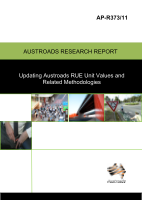Economics and Financing

- Publication no: AP-R373-11
- ISBN: 978-1-921709-59-3
- Published: 28 February 2011
- PDF (free) Download
Austroads updates of unit values and cost estimation algorithms used as inputs for urban and non-urban road investment evaluation models have become the industry standard in Australia. Updates provide a comprehensive and detailed coverage in both market and resource price terms of road user effects (RUE) inputs such as vehicle operating cost (VOC) elements (fuel, tyres, oil, repairs and maintenance), travel time elements (driver, occupant and freight), crash costs for a range of crash severity categories, and other externality costs such as congestion and emissions (environmental and social impacts).
Harmonisation of evaluation procedures and practices used by different road and transport agencies across Australia needs improvement. In addition feedback from agencies, coupled with development of better diagnostic tools has pinpointed a growing number of anomalies in evaluation algorithms (e.g. grade effects on fuel consumption, speed and tyre costs). These need to be registered and addressed in the interest of improved economic evaluation of road projects.
- 1. Introduction
- 1.1. Vehicle Operating Costs
- 1.2. Valuing Travel Time
- 1.3. Social Cost of Crashes
- 1.4. Valuation of Environmental Externalities
- 2. Road User Cost Definitions
- 2.1. Vehicle Operating Costs
- 2.2. Travel Time
- 2.3. Crash Costs
- 2.4. Environmental and Other Externalities
- 3. Vehicle Operating Costs: Methodologies and Valuation
- 3.1. Vehicle Operating Cost Models
- 3.2. Fundamental Difference between NIMPAC and HDM Type Models
- 3.3. Current Derivation Methodology
- 3.3.1. Fuel Consumption
- 3.3.2. Lubricating Oil
- 3.3.3. Tyre Use
- 3.3.4. Repair and Maintenance Costs
- 3.3.5. Capital Items: Depreciation and Interest Costs
- 3.4. Review of International Practice
- 3.4.1. Fuel Consumption Models
- 3.4.2. Oil Consumption Models
- 3.4.3. Tyre Consumption Models
- 3.4.4. Vehicle Repairs and Maintenance
- 3.4.5. Vehicle Depreciation
- 3.4.6. International VOC Models: Comparison of Algorithms
- 3.5. Methodological Issues and Challenges
- 3.5.1. Road Roughness
- 3.5.2. Repairs and Maintenance
- 3.5.3. Fleet Mix and Vehicle Characteristics
- 3.5.4. Road Network
- 3.5.5. Traffic Conditions
- 3.5.6. Carbon Tax
- 3.5.7. Tax Allowances
- 3.5.8. Model Maintenance
- 3.5.9. Maintenance Cost in BCR
- 3.5.10. Fuel Price Forecasts
- 4. Travel Time: Methodologies and valuation
- 4.1. Current Practice in Australia
- 4.1.1. Value of Travel Time for Freight Estimation
- 4.2. Recent Methodological Developments in the Literature
- 4.2.1. Travel-time Ratios: Minimum, Maximum and Optimal Thresholds
- 4.2.2. Access
- 4.2.3. Reliability of Travel Time
- 4.2.4. The Maximization of the Utility of Travel Time
- 4.2.5. Travel Time Savings
- 4.2.6. Travel for Business Purposes
- 4.2.7. Valuing Travel Time for Freight
- 4.2.8. Values of Time for Public Transport
- 4.3. Review of International Practice
- 4.3.1. United Kingdom
- 4.3.2. New Zealand
- 4.3.3. United States
- 4.4. Methodological Issues and Challenges
- 4.4.1. Valuation of Trip Purpose
- 4.4.2. Valuation of Small Time Savings
- 4.4.3. Valuation of Business Travel Time
- 4.4.4. Valuation of Private Travel Time
- 4.4.5. Valuation of Urban Time Savings
- 4.4.6. Valuation of Travel Time Reliability
- 4.4.7. Valuation of Public Transport
- 5. Crash Costs: Methodologies and Valuation
- 5.1. Human Capital Approach: Merits and Limitations
- 5.2. WTP Approach: Merits and Difficulties
- 5.3. Review of International Practice
- 5.3.1. Inter-country Comparison of Crash Costs Estimates
- 5.4. Methodological Issues and Challenges
- 5.4.1. Crash Costs vs. Other RUE Components
- 5.4.2. Implications of WTP Approach on Project Evaluation
- 5.4.3. Methodological Issues in the WTP Framework
- 5.4.4. Value of Statistical Life (VSL)
- 6. Environmental Externalities: Methodologies and Valuation
- 6.1. Methodologies Applied for Measuring Air Pollution
- 6.2. Methodologies Applied for Measuring Noise Pollution
- 6.3. Methodologies Applied for Measuring Climate Change
- 6.4. Methodologies Applied for Measuring Water Pollution
- 6.5. Methodologies Applied for Measuring Nature and Landscape; Urban Separation; and Upstream and Downstream Costs
- 6.6. Review of International Practice
- 6.6.1. The Stern Review
- 6.6.2. The Garnaut Review
- 6.6.3. The use of Monetised Values for Socio/Environmental Impacts of Road Projects (PIARC 2008)
- 6.6.4. Handbooks and Guideline Frameworks
- 6.6.5. Other International Studies
- 6.7. Methodological Issues and Challenges
- 6.7.1. The Influence of Policy Objectives
- 6.7.2. Data Restrictions and Calculation Methods
- Damage costs approach (dose-response function)
- Mitigation costs approach
- 7. Summary of Findings and Suggested Improvements in RUE Estimation
- 7.1. Vehicle Operating Costs (VOC)
- 7.1.1. VOC and Road Roughness Relationships
- 7.1.2. Vehicle Repairs and Maintenance
- 7.1.3. Model Update and Maintenance
- 7.1.4. Taxation Issues and VOC Unit Values
- 7.1.5. Fuel Price Forecasts
- 7.2. Travel Time Costs
- 7.3. Social Cost of Crashes
- 7.4. Environmental Externalities Costs
- 7.5. A Tabular Form of Findings and Challenges
- References
- Appendix A Workshop on Updating Austroads RUE Unit Values and Related Methodologies
- A.1 Melbourne, 10 March 2009 - Summary of Outcomes
- A.1.1 Vehicle Operating Costs: Methodological Issues
- A.1.2 Value of Travel Time: Methodological Issues
- A.1.3 Social Cost of Crashes: Methodological Issues
- A.1.4 Valuation of Environmental Externalities: Methodological Issues
- Commentary 1 Fuel Price Forecasts
- C1.1 Introduction
- C1.2 Current Treatment of Fuel Prices in Australia
- C1.2.1 Static Fuel Price Data
- C1.2.2 Volatility of Oil Prices
- C1.3 World Oil Forecasts
- C1.3.1 Oil Price Forecasts and Price Scenarios
- C1.3.2 Accuracy of Short- versus Long-term Forecasts
- C1.4 Country Projections
- C1.4.1 New York State Petroleum Price
- C1.4.2 U.K. Resource Costs of Fuel
- C1.4.3 Industrial Nations’ Forecast
- C1.5 Factors Affecting Fuel Price Estimates
- C1.5.1 Demand versus Supply
- C1.5.2 Technology
- C1.5.3 Government Intervention
- C1.5.4 Exogenous Shocks
- C1.5.5 Macro-economic Growth Uncertainty
- C1.5.6 Reliability of Data
- C1.6 Impact of Fuel Price Forecasts on Project Evaluation
- Commentary 2 Estimation of the Economic Costs of Crashes
